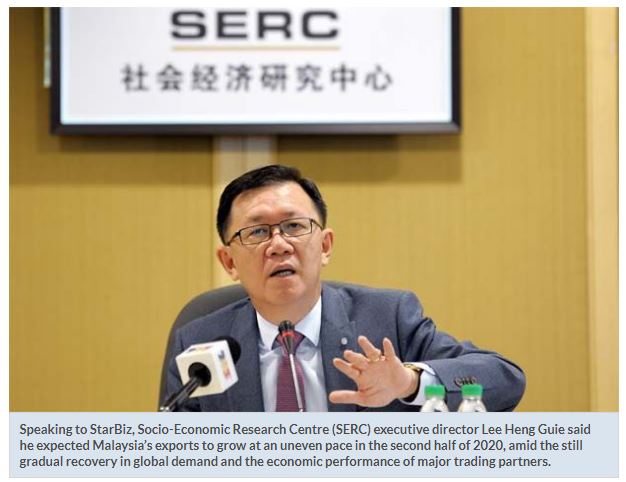Malaysia: Fragile trade outlook seen despite recovery
PETALING JAYA: As Covid-19 cases worldwide surpassed the 23 million-mark with over 800,000 deaths, global trade sentiment continues to be fragile despite the emergence of signs of recovery.
The World Trade Organisation (WTO) said that while several indicators pointed to partial upturn in world trade and output in the third quarter, the strength of such recovery remained highly uncertain.
“An L-shaped, rather than V-shaped, trajectory cannot be ruled out, ” WTO said in its latest Goods Trade Barometer report, adding that the global merchandise trade likely registered a historic fall in the April-June 2020 period.
The subdued global sentiment has put Malaysia’s outlook under the spotlight, given the country’s heavy reliance on global trade for its exports and imports.
Malaysia’s trade is valued at 123% of its GDP as of 2019 and is among the highest in the world.
Speaking to StarBiz, Socio-Economic Research Centre (SERC) executive director Lee Heng Guie said he expected Malaysia’s exports to grow at an uneven pace in the second half of 2020, amid the still gradual recovery in global demand and the economic performance of major trading partners.
The projected uneven growth is mainly because of the high monthly export levels in the second half of 2019. Exports growth are typically calculated on a year-on-year (y-o-y) basis.
By product segment, Lee pointed out that the demand for electronics and electrical products would improve, mainly helped by an increase in integrated circuits – particularly memory, logic and micro – to support the increasing usage of information technology and data solution.
Firm crude oil prices also underpinned high export value of palm oil. In addition, continued strong demand for healthcare products, chemical and chemical products will help the recovery in exports.
“Overall, we expect exports to record a smaller magnitude of contraction, estimated at 3.4% y-o-y in the second half of 2020, compared to a decline of 6.7% y-o-y in the first half of 2020. This year’s full-year export contraction is estimated at 5%.
“The ‘shock’ pandemic economic contraction has hit the trough in the second quarter and the stabilisation has started to trickle in since June, raising cautious optimism that real gross domestic products will show a much more moderate pace of decline or positive growth in the third and fourth quarter respectively.
“We caution that an occurrence of a new wave of coronavirus would temper the hope of an economic improvement in the second half of 2020. SERC estimates the economy to decline by between 3% and 4% this year, ” he said.
Lee added that the brutal numbers in March, April and May have turned around to show either shallower declines on an annual comparison basis or positive month-on-month growth in high frequency factual data in June, July and August.
“Anecdotal evidence and our channel checks indicate mixed consumer spending and business sentiment on the ground, ” he said.
Another economist told StarBiz that the country’s exports performance would naturally pick up from the lows seen in April and May as travel restrictions are eased, although it would “take some time” for the demand from trading partners to recover to pre-pandemic levels.
“We have already seen a positive growth in exports for June, after three months of continued contraction earlier.
“As our major trading partners recover from Covid-19, this will gradually allow the improvement in demand for Malaysian goods and services. In the case of the US, Reuters data showed that the number of new cases has declined for five straight weeks.
“That is a good sign for Malaysia considering that the US is one of Malaysia’s top five exporters. However, the resurgence of cases in Europe raises concerns on the potential impact on Malaysia’s export performance, moving forward, ” he said.
The recovery in trade performance, especially exports, will help to boost local production activities and in turn, accelerate Malaysia’s recovery to positive economic growth.
MIDF Research said there might be a gradual recovery starting from the third quarter, in line with the relaxation of the movement restrictions both domestically and globally.
“Government stimulus packages including Prihatin and Penjana on top of the monetary policy stimulus are expected to cushion some of the adverse impacts arising from the Covid-19 pandemic, ” it said.
The research house pointed out that Malaysia’s Leading Index (LI) rose to 4.5% y-o-y in June from 0.6% y-o-y in the previous month as more companies were allowed to resume operations and economic activities have gradually reopened by stages.
The stronger performance of the index indicates that the economy will continue to expand in the coming months.
“Similar to LI, the Coincident Index (CI) – which measures current economic performance – fell at a softer rate by 3.1% y-o-y compared to negative 11% y-o-y in the preceding month, recovering from the impact of 2½ months of the movement control order where businesses were closed and demand declined.
“The improvement in the CI was mainly driven by the recovery in industrial production and higher capacity utilisation in the manufacturing sector, ” it said.
Source: https://www.thestar.com.my/business/business-news/2020/08/26/fragile-trade-outlook-seen-despite-recovery


 Thailand
Thailand





